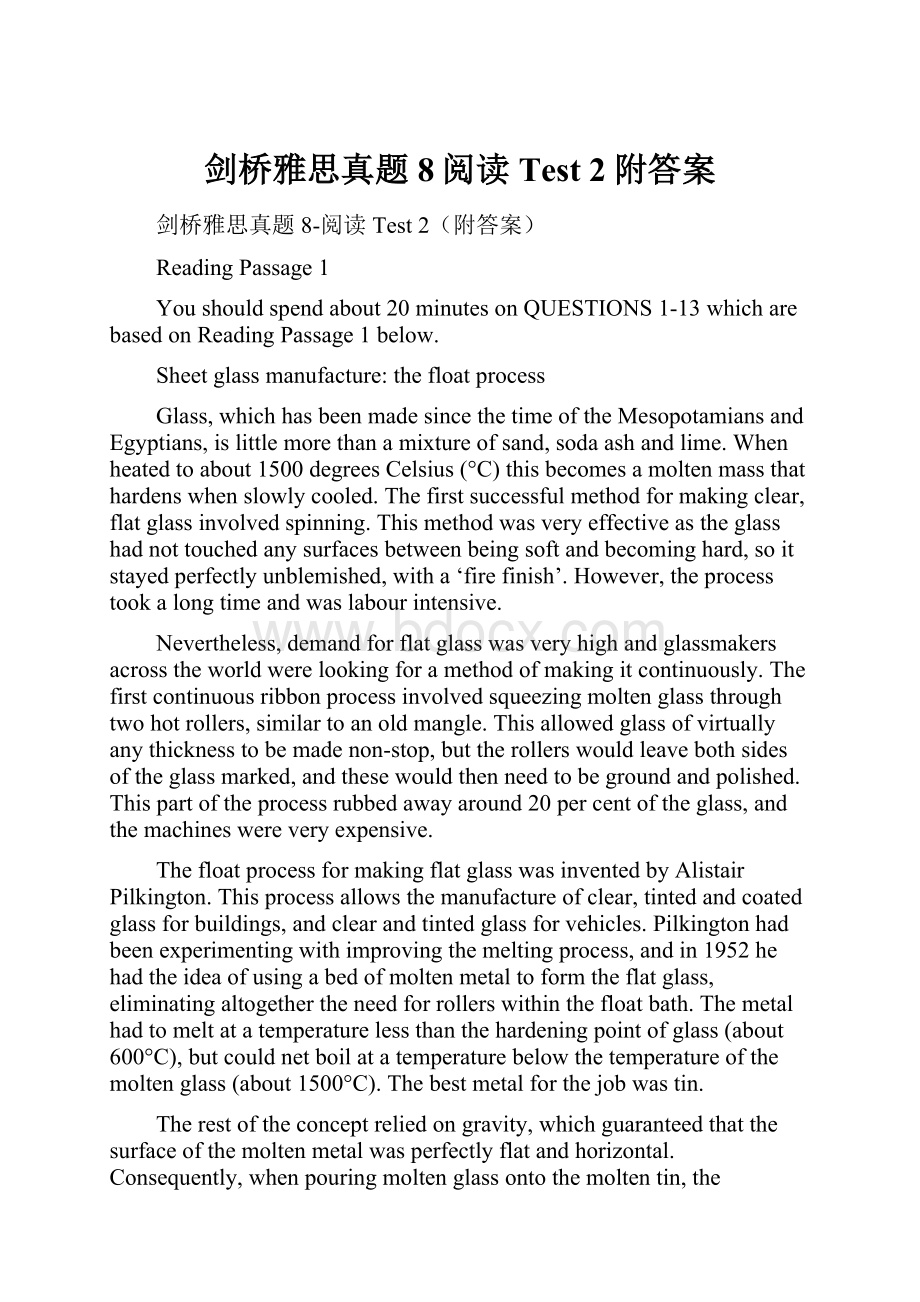剑桥雅思真题8阅读Test 2附答案.docx
《剑桥雅思真题8阅读Test 2附答案.docx》由会员分享,可在线阅读,更多相关《剑桥雅思真题8阅读Test 2附答案.docx(13页珍藏版)》请在冰豆网上搜索。

剑桥雅思真题8阅读Test2附答案
剑桥雅思真题8-阅读Test2(附答案)
ReadingPassage1
Youshouldspendabout20minutesonQUESTIONS1-13whicharebasedonReadingPassage1below.
Sheetglassmanufacture:
thefloatprocess
Glass,whichhasbeenmadesincethetimeoftheMesopotamiansandEgyptians,islittlemorethanamixtureofsand,sodaashandlime.Whenheatedtoabout1500degreesCelsius(°C)thisbecomesamoltenmassthathardenswhenslowlycooled.Thefirstsuccessfulmethodformakingclear,flatglassinvolvedspinning.Thismethodwasveryeffectiveastheglasshadnottouchedanysurfacesbetweenbeingsoftandbecominghard,soitstayedperfectlyunblemished,witha‘firefinish’.However,theprocesstookalongtimeandwaslabourintensive.
Nevertheless,demandforflatglasswasveryhighandglassmakersacrosstheworldwerelookingforamethodofmakingitcontinuously.Thefirstcontinuousribbonprocessinvolvedsqueezingmoltenglassthroughtwohotrollers,similartoanoldmangle.Thisallowedglassofvirtuallyanythicknesstobemadenon-stop,buttherollerswouldleavebothsidesoftheglassmarked,andthesewouldthenneedtobegroundandpolished.Thispartoftheprocessrubbedawayaround20percentoftheglass,andthemachineswereveryexpensive.
ThefloatprocessformakingflatglasswasinventedbyAlistairPilkington.Thisprocessallowsthemanufactureofclear,tintedandcoatedglassforbuildings,andclearandtintedglassforvehicles.Pilkingtonhadbeenexperimentingwithimprovingthemeltingprocess,andin1952hehadtheideaofusingabedofmoltenmetaltoformtheflatglass,eliminatingaltogethertheneedforrollerswithinthefloatbath.Themetalhadtomeltatatemperaturelessthanthehardeningpointofglass(about600°C),butcouldnetboilatatemperaturebelowthetemperatureofthemoltenglass(about1500°C).Thebestmetalforthejobwastin.
Therestoftheconceptreliedongravity,whichguaranteedthatthesurfaceofthemoltenmetalwasperfectlyflatandhorizontal.Consequently,whenpouringmoltenglassontothemoltentin,theundersideoftheglasswouldalsobeperfectlyflat.Iftheglasswerekepthotenough,itwouldflowoverthemoltentinuntilthetopsurfacewasalsoflat,horizontalandperfectlyparalleltothebottomsurface.Oncetheglasscooledto604°Corlessitwastoohardtomarkandcouldbetransportedoutofthecoolingzonebyrollers.Theglasssettledtoathicknessofsixmillimetresbecauseofsurfacetensioninteractionsbetweentheglassandthetin.Byfortunatecoincidence,60percentoftheflatglassmarketatthattimewasforsix-millimetreglass.
Pilkingtonbuiltapilotplantin1953andby1955hehadconvincedhiscompanytobuildafull-scaleplant.However,ittook14monthsofnon-stopproduction,costingthecompany£100,000amonth,beforetheplantproducedanyusableglass.Furthermore,oncetheysucceededinmakingmarketableflatglass,themachinewasturnedoffforaservicetoprepareitforyearsofcontinuousproduction.Whenitstartedupagainittookanotherfourmonthstogettheprocessrightagain.Theyfinallysucceededin1959andtherearenowfloatplantsallovertheworld,witheachabletoproducearound1000tonsofglasseveryday,non-stopforaround15years.
Floatplantstodaymakeglassofnearopticalquality.Severalprocesses-melting,refining,homogenising-takeplacesimultaneouslyinthe2000tonnesofmoltenglassinthefurnace.Theyoccurinseparatezonesinacomplexglassflowdrivenbyhightemperatures.Itaddsuptoacontinuousmeltingprocess,lastingaslongas50hours,thatdeliversglasssmoothlyandcontinuouslytothefloatbath,andfromtheretoacoatingzoneandfinallyaheattreatmentzone,wherestressesformedduringcoolingarerelieved.
Theprincipleoffloatglassisunchangedsincethe1950s.However,theproducthaschangeddramatically,fromasinglethicknessof6.8mmtoarangefromsub-millimetreto25mm,fromaribbonfrequentlymarredbyinclusionsandbubblestoalmostopticalperfection.Toensurethehighestquality,inspectiontakesplaceateverystage.Occasionally,abubbleisnotremovedduringrefining,asandgrainrefusestomelt,atremorinthetinputsripplesintotheglassribbon.Automatedon-lineinspectiondoestwothings.Firstly,itrevealsprocessfaultsupstreamthatcanbecorrected.Inspectiontechnologyallowsmorethan100millionmeasurementsasecondtobemadeacrosstheribbon,locatingflawstheunaidedeyewouldbeunabletosee.Secondly,itenablescomputersdownstreamtosteercuttersaroundflaws.
Floatglassissoldbythesquaremetre,andatthefinalstagecomputerstranslatecustomerrequirementsintopatternsofcutsdesignedtominimisewaste.
Question1-8
Completethetableanddiagrambelow.
ChooseNOMORETHANTWOWORDSfromthepassageforeachanswer.
Writeyouranswersinboxesonyouranswersheet.
Earlymethodsofproducingflatglass
Method
Advantage
Disadvantage
1…………
•Glassremained
2…………
•Slow
3…………
Ribbon
•Couldproduceglasssheetsofvarying4…………
•Non-stopprocess
•Glasswas5…………
•20%ofglassrubbedaway
•Machineswereexpensive
Question9-13
DothefollowingstatementsagreewiththeinformationgiveninReadingPassage1?
Inboxes9-13onyouranswersheet,write
TRUEifthestatementagreeswiththeinformation
FALSEifthestatementcontradictstheinformation
NOTGIVENifthereisnoinformationonthisinthepassage
9.Themetalusedinthefloatprocesshadtohavespecificproperties.
10.Pilkingtoninvestedsomeofhisownmoneyinhisfloatplant.
11.Pilkington'sfirstfull-scaleplantwasaninstantcommercialsuccess.
12.TheprocessinventedbyPilkingtonhasnowbeenimproved.
13.Computersarebetterthanhumansatdetectingfaultsinglass.
ReadingPassage2
Youshouldspendabout20minutesonQUESTIONS14-26whicharebasedonReadingPassage2below.
TheLittleIceAge
AThisbookwillprovideadetailedexaminationoftheLittleIceAgeandotherclimaticshifts,but,beforeIembarkonthat,letmeprovideahistoricalcontext.Wetendtothinkofclimate-asopposedtoweather-assomethingunchanging,yethumanityhasbeenatthemercyofclimatechangeforitsentireexistence,withatleasteightglacialepisodesinthepast730,000years.OurancestorsadaptedtotheuniversalbutirregularglobalwarmingsincetheendofthelastgreatIceAge,around10,000yearsago,withdazzlingopportunism.Theydevelopedstrategiesforsurvivingharshdroughtcycles,decadesofheavyrainfallorunaccustomedcold;adoptedagricultureandstock-raising,whichrevolutionizedhumanlife;andfoundedtheworld'sfirstpre-industrialcivilizationsinEgypt,MesopotamiaandtheAmericas.Butthepriceofsuddenclimatechange,infamine,diseaseandsuffering,wasoftenhigh.
BTheLittleIceAgelastedfromroughly1300untilthemiddleofthenineteenthcentury.Onlytwocenturiesago,Europeexperiencedacycleofbitterlycoldwinters;mountainglaciersintheSwissAlpswerethelowestin-recordedmemory,andpackicesurroundedIcelandformuchoftheyear.TheclimaticeventsoftheLittleIceAgedidmorethanhelpshapethemodernworld.Theyarethedeeplyimportantcontextforthecurrentunprecedentedglobalwarming.TheLittleIceAgewasfarfromadeepfreeze,however;ratheranirregularseesawofrapidclimaticshifts,fewlastingmorethanaquarter-century,drivenbycomplexandstilllittleunderstoodinteractionsbetweentheatmosphereandtheocean.Theseesawbroughtcyclesofintenselycoldwintersandeasterlywinds,thenswitchedabruptlytoyearsofheavyspringandearlysummerrains,mildwinters,andfrequentAtlanticstorms,ortoperiodsofdroughts,lightnortheasterlywinds,andsummerheatwaves.
CReconstructingtheclimatechangesofthepastisextremelydifficult,becausesystematicweatherobservationsbeganonlyafewcenturiesago,inEuropeandNorthAmerica.RecordsfromIndiaandtropicalAfricaareevenmorerecent.Forthetimebeforerecordsbegan,wehaveonly'proxyrecords'reconstructedlargelyfromtreeringsandicecores,supplementedbyafewincompletewrittenaccounts.Wenowhavehundredsoftree-ringrecordsfromthroughoutthenorthernhemisphere,andmanyfromsouthoftheequator,too,amplifiedwithagrowingbodyoftemperaturedatafromicecoresdrilledinAntarctica,GreenlandthePeruvianAndes,andotherlocations.Weareclosetoknowledgeofannualsummerandwintertemperaturevariationsovermuchofthenorthernhemispheregoingback600years.
DThisbookisanarrativehistoryofclimaticshiftsduringthepasttencenturies,andsomeofthewaysinwhichpeopleinEuropeadaptedtothem.PartOnedescribestheMedievalWarmPeriod,roughly900t01200.Duringthesethreecenturies,NorsevoyagersfromNorthernEuropeexplorednorthernseas,settledGreenland,andvisitedNorthAmerica.Itwasnotatimeofuniformwarmth,forthen,asalwayssincetheGreatIceAge,therewereconstantshiftsinrainfallandtemperature.MeanEuropeantemperatureswereaboutthesameastoday,perhapsslightlycooler.
EItisknownthattheLittleIceAgecoolingbeganinGreenlandandtheArcticinabout1200.AstheArcticicepackspreadsouthward,NorsevoyagestothewestwerereroutedintotheopenAtlantic,thenendedaltogether.StorminessincreasedintheNorthAtlanticandNorthSea.Colder,muchwetterweatherdescendedonEuropebetween1315and1319,whenthousandsperishedinacontinent-widefamine.By1400,theweatherhadbecomedecidedlymoreunpredictableandstormier,withsuddenshiftsandlowertemperaturesthatculminatedinthecolddecadesofthelatesixteenthcentury.Fishwereavita